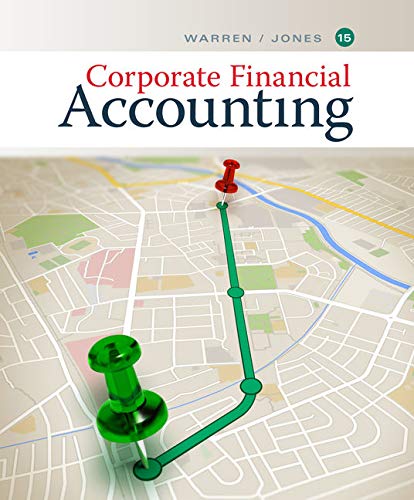
(a)
Inventory turnover ratio: Inventory turnover ratio is used to determine the number of times inventory used or sold during the particular accounting period. The formula to calculate the inventory turnover ratio is as follows:
To determine: the inventory turnover for Company T and Company A
(a)
Answer to Problem 6.1MAD
Explanation of Solution
The inventory turnover ratio for Company T is calculated as follows:
Working notes:
The average inventory is calculated as follows:
The inventory turnover ratio for Company A is calculated as follows:
Working notes:
The average inventory is calculated as follows:
The inventory turnover ratio is calculated by dividing cost of goods sold by average inventory during the period. The average inventory is calculating by dividing beginning inventory and ending inventory by 2. The inventory turnover ratio is an important measure as to how efficient is the management is good at managing inventory and achieving sales from it.
Therefore, the inventory turnover of Company T is 6.2 Times & the inventory turnover of Company A is 7.7 Times.
(b)
Days’ sales in inventory: Days’ sales in inventory are used to determine number of days a particular company takes to make sales of the inventory available with them. The formula to calculate the days’ sales in inventory ratio is as follows:
To determine: the Days’ sales in inventory ratio Company T and Company A.
(b)
Answer to Problem 6.1MAD
Explanation of Solution
The Days’ sale in inventory ratio for Company T is calculated as follows:
The Days’ sale in inventory ratio for Company A is calculated as follows:
The Days’ sales in inventory ratio are calculated by dividing days in accounting period by inventory turnover ratio. The Days’ sale in inventory ratio is an important measure to know how long the company is holding the inventory before selling when compared to its peers.
Therefore, the Days’ sales in inventory of Company T are 58.8 days, & the Days’ sales in inventory of Company A is 47.4 days.
(c)
Inventory turnover ratio: Inventory turnover ratio is used to determine the number of times inventory used or sold during the particular accounting period. The formula to calculate the inventory turnover ratio is as follows:
To state: the company that has better inventory efficiency.
(c)
Answer to Problem 6.1MAD
Explanation of Solution
The company A has higher inventory turnover ratio of 7.7 and lesser number of days’ sales in inventory of 47.4 days when compared to company T’s inventory turnover ratio of 6.2 and number of days’ sales in inventory of 58.8 days.
(d)
Inventory turnover ratio: Inventory turnover ratio is used to determine the number of times inventory used or sold during the particular accounting period. The formula to calculate the inventory turnover ratio is as follows:
Days’ sales in inventory: Days’ sales in inventory are used to determine number of days a particular company takes to make sales of the inventory available with them. The formula to calculate the days’ sales in inventory ratio is as follows:
To explain: the difference in inventory efficiency between two companies.
(d)
Explanation of Solution
The main difference in the inventory efficiency between both the companies is that merchandising strategy followed. The Company A uses internet as medium for selling goods and direct shipping of merchandise inventory is not handled as company A’s inventory, whereas company T uses traditional retail store method which makes them to stock more level of inventory in retail outlet. The company T’s strategy requires a significant investment in inventory as it can be seen in its inventory turnover and number of days’ sales in inventory
Want to see more full solutions like this?
Chapter 6 Solutions
Cengagenowv2, 1 Term Printed Access Card For Warren/jones’ Corporate Financial Accounting, 15th
- Can you solve this financial accounting issue?arrow_forwardPlease provide answer this financial accounting question not use aiarrow_forwardOPD, who is claimed as a dependent by his parents, is 17. He received income of $3,400 from a trust fund and $700 from wages. He had $1,200 in itemized deductions. What is his taxable income? I need help with this financial accounting problem using accurate calculation methods.arrow_forward
- Please Solve this Questionarrow_forwardTechtronic Inc., a manufacturing company, has just completed an order that Micro Solutions placed for 150 gadgets. The direct material, purchased parts, and direct labor costs for the Micro order are as follows: • Cost of direct materials: $54,000 • Cost of purchased parts: $30,000 • Direct labor hours: 300 hours • • Average direct labor pay rate: $18 per hour Overhead costs were applied at a plant wide overhead rate of 250 percent of direct labor dollars. Compute the total cost of the Micro order.arrow_forwardHello tutor please given General accounting question answer do fast and properly explain all answerarrow_forward
 Financial And Managerial AccountingAccountingISBN:9781337902663Author:WARREN, Carl S.Publisher:Cengage Learning,
Financial And Managerial AccountingAccountingISBN:9781337902663Author:WARREN, Carl S.Publisher:Cengage Learning, Managerial AccountingAccountingISBN:9781337912020Author:Carl Warren, Ph.d. Cma William B. TaylerPublisher:South-Western College Pub
Managerial AccountingAccountingISBN:9781337912020Author:Carl Warren, Ph.d. Cma William B. TaylerPublisher:South-Western College Pub Financial AccountingAccountingISBN:9781305088436Author:Carl Warren, Jim Reeve, Jonathan DuchacPublisher:Cengage Learning
Financial AccountingAccountingISBN:9781305088436Author:Carl Warren, Jim Reeve, Jonathan DuchacPublisher:Cengage Learning Essentials of Business Analytics (MindTap Course ...StatisticsISBN:9781305627734Author:Jeffrey D. Camm, James J. Cochran, Michael J. Fry, Jeffrey W. Ohlmann, David R. AndersonPublisher:Cengage Learning
Essentials of Business Analytics (MindTap Course ...StatisticsISBN:9781305627734Author:Jeffrey D. Camm, James J. Cochran, Michael J. Fry, Jeffrey W. Ohlmann, David R. AndersonPublisher:Cengage Learning Managerial Accounting: The Cornerstone of Busines...AccountingISBN:9781337115773Author:Maryanne M. Mowen, Don R. Hansen, Dan L. HeitgerPublisher:Cengage Learning
Managerial Accounting: The Cornerstone of Busines...AccountingISBN:9781337115773Author:Maryanne M. Mowen, Don R. Hansen, Dan L. HeitgerPublisher:Cengage Learning




